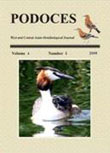فهرست مطالب

Podoces
Volume:4 Issue: 1, 2009
- تاریخ انتشار: 1388/06/01
- تعداد عناوین: 7
-
Page 1Based on original literature reports covering the period 1860–1969, details of362 records of 102 bird species considered rare in Iran are presented. This fills a gap inknowledge of Iran’s birds from a period between research by Gmelin and Hablizl in the1770s (reviewed by Mlikovsky 2008) and an overview of the observations of rare birds inIran in the 1960s and 1970s (presented by Scott 2008). Attention is drawn to two newspecies for Iran (Eastern Marsh Harrier Circus spilonotus and Blue Whistling ThrushMyophonus caeruleus). Published details validate the records of Light-bellied Brent GooseBranta hrota, Upland Buzzard Buteo hemilasius, Great Knot Calidris tenuirostris, andOriental Cuckoo Cuculus saturatus, formerly considered as of dubious occurrence in Iran.Information on six species (Yellow-breasted Tit Cyanistes cyanus flavipectus, FalcatedDuck Anas falcata, Indian Nightjar Caprimulgus asiaticus, Güldenstädt’s RedstartPhoenicurus erythrogaster, Cirl Bunting Emberiza cirlus and Eurasian NutcrackerNucifraga caryocatactes) was considered insufficient or unreliable and the occurrence ofthese species in Iran has been rejected. We recommend that these species be omitted from the last revised checklist of the birds of Iran (Scott & Adhami 2006). Accordingly, theupdated checklist of the birds of Iran reaches 522 species (including five recently addedspecies, namely Sooty Shearwater Puffinus gravis, Barnacle Goose Branta leucopsis, Rednecked Stint Calidris ruficollis, Namaqua Dove Oena capensis and Red-vented BulbulPycnonotus cafer).
-
Page 28The population of Black Francolin was studied during the 2007–2008 period inSistan Plain in relation to plant vegetation and drought. The distribution of the species was mapped for the periods of before (2000) and after the drought (2000–2008) divided into three groups of habitats. Monthly Black Francolin number in Sistan is given for the 1995– 2007 period based on data obtained from Zabol Office of the Department of theEnvironment with a maximum number of 2,740 recorded in December 1999. Details of bird number are also given for some areas during the 2004–2007 period. Additionally plantcoverage preferred by Black Francolin was studied in two areas of Niyatak Forest andDoost Muhammad Khan. A total of 33 plant species was identified in Niyatak and 28species in Doost Muhammad Khan. The dominant plant species in spring was Phragmitesaustralis in Niyatak and Stuvvie sp. in Doost Muhammd Khan; however Alhaji camelorumwas the dominant species in summer and overall in both areas. Of 23 plots in Niyatak,crown cover of 30–40% and height of 50–60 cm had more birds and of 59 plots in DoostMuhammad Khan, crown cover of 20–30% and height of 20–30 cm also had more birdsdetected. Of 18 nests, clutch size varied from 4 to 11 eggs. Drought and illegal hunting are two main threatening factors for the Black Francolin population in Sistan Plain.
-
Page 37The breeding ecology of Grey Heron was studied during 2008 and 2009 breedingseasons in Siahkeshim Protected Area of Anzali Wetland. In this study the chicks have been monitored in the nesting, egg-laying and fledgling stages. The nests were oval-shaped and the following parameters were measured: greater and smaller external diameter, greater and smaller internal diameter, external height and depth of nest. In the first year, the average clutch size (totaling 91 eggs) was 4.33±0.68, whereas the average number of hatched eggs and the average numbers of chicks surviving to fledging were 80.2% and 78.02%, respectively. In other words, 3.38 chicks, on average, arrived to fledging per nest in this region. But, in the second year, there were only five active nests with a total of 14 eggs from which only one egg hatched and fledged. The reduction of nesting and breeding success in the second year is compared anddiscussed.
-
Page 44Five wetlands in south Caspian lowlands have been selected in order to studytheir birds, namely Miankaleh, Fereidoon-Kenar, Bujagh, Anzali and Lavandevil. Allobservations were made using high-quality binoculars and a telescope on twice-monthlyvisits from spring 2006 to early January 2007. In respect to bird species, in spring Bujaghand Anzali with 82 were the predominant wetlands, whereas in summer it was Bujagh with 87, in autumn Bujagh with 144 and in winter Miankaleh with 148. The peak numbers of birds recorded were: Eurasian Teal A. crecca (146,000 in Bujagh, 29,000 in Anzali),Mallard Anas platyrhynchos (35,000 in Miankaleh), Greylag Goose Anser anser (23,050 in Miankaleh), Eurasian Coot Fulica atra (19,940 in Minakaleh and 13,000 in Bujagh) and Caspian Gull Larus cachinnans (1142 in Bujagh). The season-to season fluctuations of bird numbers have been estimated. A few suggestions have been made on the improvements to the conservation of the wetlands.
-
Page 60During the field surveys conducted approximately once a week at the Abshineh Dam from September 2007 to June 2008, 42 waterbird species were identified. The highest number of species was observed in September 2007 and May 2008 (26 species) while the highest bird density was recorded in November (58 per 10 ha). The commonest species were Eurasian Coot Fulica atra (26.2%) and Mallard Anas platyrhynchos (18.56%).
-
Page 64The records of Marsh Warbler Acrocephalus palustris between 2003 and 2008 in Southeastern Anatolia were evaluated for the distribution of this species. The available records indicate that the distribution of the Marsh Warbler is restricted to a few localities, mainly during the autumn migration season.
-
Page 67A national programme was organised to estimate the population size of eight species of the Corvidae in Iran during the period from November 2001 to September 2002 and revealed that the maximum number of 259,497 individuals were counted inwinter. The highest counts were 71,983 corvids in the Hamedan Province and 50,000 individuals of Rook Corvus frugilegus.

